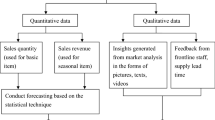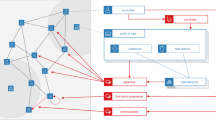Abstract
This paper addresses the impact of consumer purchasing behaviour on the production planning of perishable food products for companies operating in the fast moving consumer goods using direct store delivery. The research presented here builds on previous marketing studies related to the effects of expiry dates in order to derive mathematical formulae, which express the age dependent demand for different categories of perishable products. These demand expressions take into account both customer willingness to pay and product quality risk. The paper presents deterministic and stochastic production planning models, which incorporate the customer’s eagerness to pick up the fresher products available. Results indicate that model approximations neglecting the fact that customers pick up the fresher products or considering that all products have the same product quality risk have a reduced impact on profit losses. On the other hand, not considering the decreasing customer willingness to pay has an important impact both on the profit losses and on the amount of spoiled products.















Similar content being viewed by others
References
Abad P (2001) Optimal price and order size for a reseller under partial backordering. Comput Oper Res 28:53–65
Abad PL (2003) Optimal pricing and lot-sizing under conditions of perishability, finite production and partial backordering and lost sale. Eur J Oper Res 144:677–685
Ahumada O, Villalobos JR (2011) Operational model for planning the harvest and distribution of perishable agricultural products. Int J Prod Econ 133:677–687
Akkerman R, Farahani P, Grunow M (2010) Quality, safety and sustainability in food distribution: a review of quantitative operations management approaches and challenges. OR Spectr 32:863–904
Amorim P, Antunes CH, Almada-Lobo B (2011a) Multi-objective lot-sizing and scheduling dealing with perishability issues. Ind Eng Chem Res 50:3371–3381
Amorim P, Günther H-O, Almada-Lobo B (2012) Multi-objective integrated production and distribution planning of perishable products. Int J Prod Econ 138:89–101
Amorim P, Meyr H, Almeder C, Almada-Lobo B (2011b) Managing perishability in production-distribution planning: a discussion and review. Flexible Serv Manuf J 1–25. doi:10.1007/s10696-011-9122-3
Andreyeva T, Long MW, Brownell KD (2010) The impact of food prices on consumption: a systematic review of research on the price elasticity of demand for food. Am J Publ Health 100:216–22
Bilgen B, Günther H-O (2009) Integrated production and distribution planning in the fast moving consumer goods industry: a block planning application. OR Spectr 32:927–955
Birge JR, Louveaux F (2011) Introduction to stochastic programming. In: Springer series in operations research. Springer, New York
Broekmeulen RA, van Donselaar KH (2009) A heuristic to manage perishable inventory with batch ordering, positive lead-times, and time-varying demand. Comput Oper Res 36:3013–3018
Buschkühl L, Sahling F, Helber S, Tempelmeier H (2008) Dynamic capacitated lot-sizing problems: a classification and review of solution approaches. OR Spectr 32:231–261
Chang H, Teng J, Ouyang L, Dye C (2006) Retailer’s optimal pricing and lot-sizing policies for deteriorating items with partial backlogging. Eur J Oper Res 168:51–64
Chen J, Chen L (2005) Pricing and production lot-size/scheduling with finite capacity for a deteriorating item over a finite horizon. Comput Oper Res 32:2801–2819
Costa AM, Santos LMR, Alem DJ, Santos RHS (2013) Sustainable vegetable crop supply problem with perishable stocks. Ann Oper Res 1–19
Drexl A, Kimms A (1997) Lot sizing and scheduling G Survey and extensions. Eur J Oper Res 99:221–235
Dyllick T (1989) Ecological marketing strategy for Toni yogurts in Switzerland. J Bus Ethics 8:657–662
Fleischmann B, Meyr H (1997) The general lotsizing and scheduling problem. OR Spektr 19:11–21
Günther H-O, Grunow M, Neuhaus U (2006) Realizing block planning concepts in make-and-pack production using MILP modelling and SAP APO. Int J Prod Res 44:3711–3726
Haase K, Kimms A (2000) Lot sizing and scheduling with sequence-dependent setup costs and times and efficient rescheduling opportunities. Int J Prod Econ 66:159–169
Jans R, Degraeve Z (2008) Modeling industrial lot sizing problems: a review. Int J Prod Res 46:1619–1643
Karaesmen I, Scheller-Wolf A, Deniz B (2011) Managing perishable and aging inventories: review and future research directions. In: Kempf K, Keskinocak P, Uzsoy R (eds) Handbook of production planning. Kluwer international series in operations research and management science. Kluwer, Dordrecht
Karimi B, Fatemi Ghomi S, Wilson J (2003) The capacitated lot sizing problem: a review of models and algorithms. Omega 31:365–378
Krarup J, Bilde O (1977) Plant location, set covering and economic lot sizes: an O(mn) algorithm for structured problems. In: Collatz L et al (eds) Birkhauser Verlag. Basel
Lütke Entrup M (2005) Shelf life integration in sausage production. In: Advanced planning in fresh food industries contributions to management science. Physica-Verlag HD, pp 179–195
Lütke Entrup M, Günther H-O, Van Beek P, Grunow M, Seiler T (2005) Mixed-integer linear programming approaches to shelf-life-integrated planning and scheduling in yoghurt production. Int J Prod Res 43:5071–5100
Marinelli F, Nenni ME, Sforza A (2007) Capacitated lot sizing and scheduling with parallel machines and shared buffers: a case study in a packaging company. Ann Oper Res 150:177–192
Nahmias S (1982) Perishable inventory theory: a review. Oper Res 30:680–708
Otto A, Schoppengerd FJ, Shariatmadari R (2009) Success in the consumer products market: understanding direct store delivery. In: Shariatmadari R, Schoppengerd FJ, Otto A (eds) Direct store delivery. Springer, Berlin, pp 1–29
Pahl J, Voß S (2010) Discrete lot-sizing and scheduling including deterioration and perishability constraints. In: Dangelmaier W, Blecken A, Delius R, Klöpfer S (eds) Advanced manufacturing and sustainable logistics. Lecture notes in business information processing, vol 46. Springer, Berlin, pp 345–357
Pahl J, Voß S, Woodruff DL (2011) Discrete lot-sizing and scheduling with sequence-dependent setup times and costs including deterioration and perishability constraints. In: IEEE, HICSS-44
Rong A, Akkerman R, Grunow M (2011) An optimization approach for managing fresh food quality throughout the supply chain. Int J Prod Econ 131:421–429
Sen S, Block LG (2009) “Why My Mother Never Threw Anything Out”: the effect of product freshness on consumption. J Consumer Res 36:47–55
Sodhi M (2005) Managing demand risk in tactical supply chain planning for a global consumer electronics company. Prod Oper Manage 14:69–79
Tometzki T, Engell S (2010) Risk management in production planning under uncertainty by multi-objective hybrid evolutionary algorithms. In: Computer aided chemical engineering, vol 28. Elsevier, Amsterdam, pp 151–156
Tsiros M, Heilman CM (2005) The effect of expiration dates and perceived risk on purchasing behavior in grocery store perishable categories. J Market 69:114–129
Van Woensel T, Van Donselaar K, Broekmeulen R, Fransoo J (2007) Consumer responses to shelf out-of-stocks of perishable products. Int J Phys Distrib Logist Manage 37:704–718
Zhu X, Wilhelm W (2006) Scheduling and lot sizing with sequence-dependent setup: a literature review. IIE Trans 38:987–1007
Acknowledgments
The first author appreciate the support of the FCT Grant SFRH/BPD/89861/2012 and the FCT Project PTDC/EGE-GES/104443/2008.
Author information
Authors and Affiliations
Corresponding author
Rights and permissions
About this article
Cite this article
Amorim, P., Costa, A.M. & Almada-Lobo, B. Influence of consumer purchasing behaviour on the production planning of perishable food. OR Spectrum 36, 669–692 (2014). https://doi.org/10.1007/s00291-013-0324-9
Published:
Issue Date:
DOI: https://doi.org/10.1007/s00291-013-0324-9




